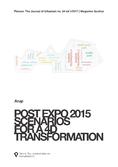cities anthropology information technology social exclusion/integration tourism spatial planning ecology networks city-regions design premio letteratura urbanistica public art ricerca housing ecological networks digitalization commerce strategic planning representation resilience urban form identity inu study day smart city energy
Post Expo 2015 | Scenarios for a 4D Transformation
Arup
After Expo 2015, Milan was left with an unprecedented legacy, both in its built environment and in the wider reputation of the city. Expo occupied a 100-hectare site, which is now fully equipped to provide services to a new community of 1000 individuals. At the same time, the event significantly improved Milan's international standing, presenting the city as an open, multicultural, safe and efficient global metropolis, with standards equal to New York, London and Berlin.
Recently, the Italian government has committed to invest in the Expo site as part of a strategic initiative for the future of the national economy called the Human Technopole. The aim is to develop a world-class research centre for the sciences, one that will act as an international beacon for the brightest minds. Yet a fertile ecosystem still needs to be devised in order to make the disruptive potential of this plan successful; a context where the leading industrial and academic institutions, supported by complementary services, can provide a vibrant environment for people to live, work and play.
Current plans for the Human Technopole are limited to a small portion of the Expo site, approximately 10%. However, a series of compelling proposals for a broader development have emerged in the past few months. These would require substantial public and private investment, something that is unlikely to be unlocked in the near future, given the current economic climate. For this reason, Arup designed an alternative methodology to address the transformation of the Expo area, one that introduces time as a fourth dimension and essential factor to enable a clear policy of progressive development.
Based on our experience in extensive regeneration projects such as Kings Cross and Stratford in London, the methodology we propose introduces a dynamic transformation of the entire Expo site. Instead of being constrained within a single masterplan, the transformation evolves over time, following the blueprint of four scenarios that each unfold according to different compositions of vocations and functions.
Each of the four scenarios considers a different option for the gradual release of public and private resources. Evolving in time – the fourth dimension – these scenarios can accommodate the necessary flexibility required by economic uncertainty.
The scenarios illustrate four steps for a dynamic and progressive distribution of ingredients, vocations and functions that will populate the Expo area. The different options consider fluctuations in investment, which are driven by a range of interconnected factors, including the desirability of the site, the health of the broader economy and the engagement of public and private stakeholders, both at a local and national scale.
This plan envisions a framework that can be adapted over time to changing needs by enabling the implementation of pilot projects at different stages of the site development. Guided by this framework, the scenarios aim to reinforce the synergy between academic research and industry by radically reconsidering procedures and timeframes for its delivery.
This transformative approach is reflected in the names of the four scenarios, starting from the prevalence of nature and moving on to the creation of a community of explorers, to the embryo of an innovative district, which evolves in a future city. Together these scenarios tell the story of a cohesive project that evolves and develops its strength over time.
DOWNLOAD FULL THE ARTICLE!
• This article must be quoted as: Arup (2017), "Post Expo 2015. Scenarios for a 4D Transformation", Planum. The Journal of Urbanism n.34 vol I/2017, Roma-Milano, pp. 1-10.
OTHER MATERIALS ABOUT EXPO ON PLANUM:
• Isabella Susi Botto e Stefano Di Vita (2015), "EXPO: quale legacy per il futuro di Milano", Planum. The Journal of Urbanism n.31 vol II/2015, Roma-Milano.
Related articles:




Planum
The Journal of Urbanism
ISSN 1723-0993
owned by
Istituto Nazionale di Urbanistica
published by
Planum Association
ISSN 1723-0993 | Registered at Court of Rome 4/12/2001, num. 514/2001
Web site realized by ChannelWeb & Planum Association | Powered by BEdita 3







